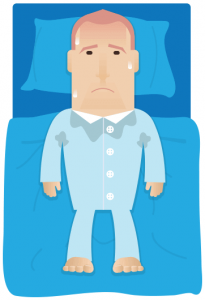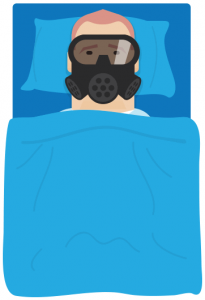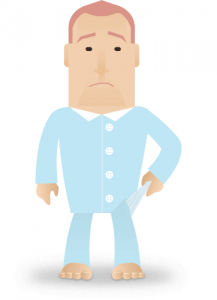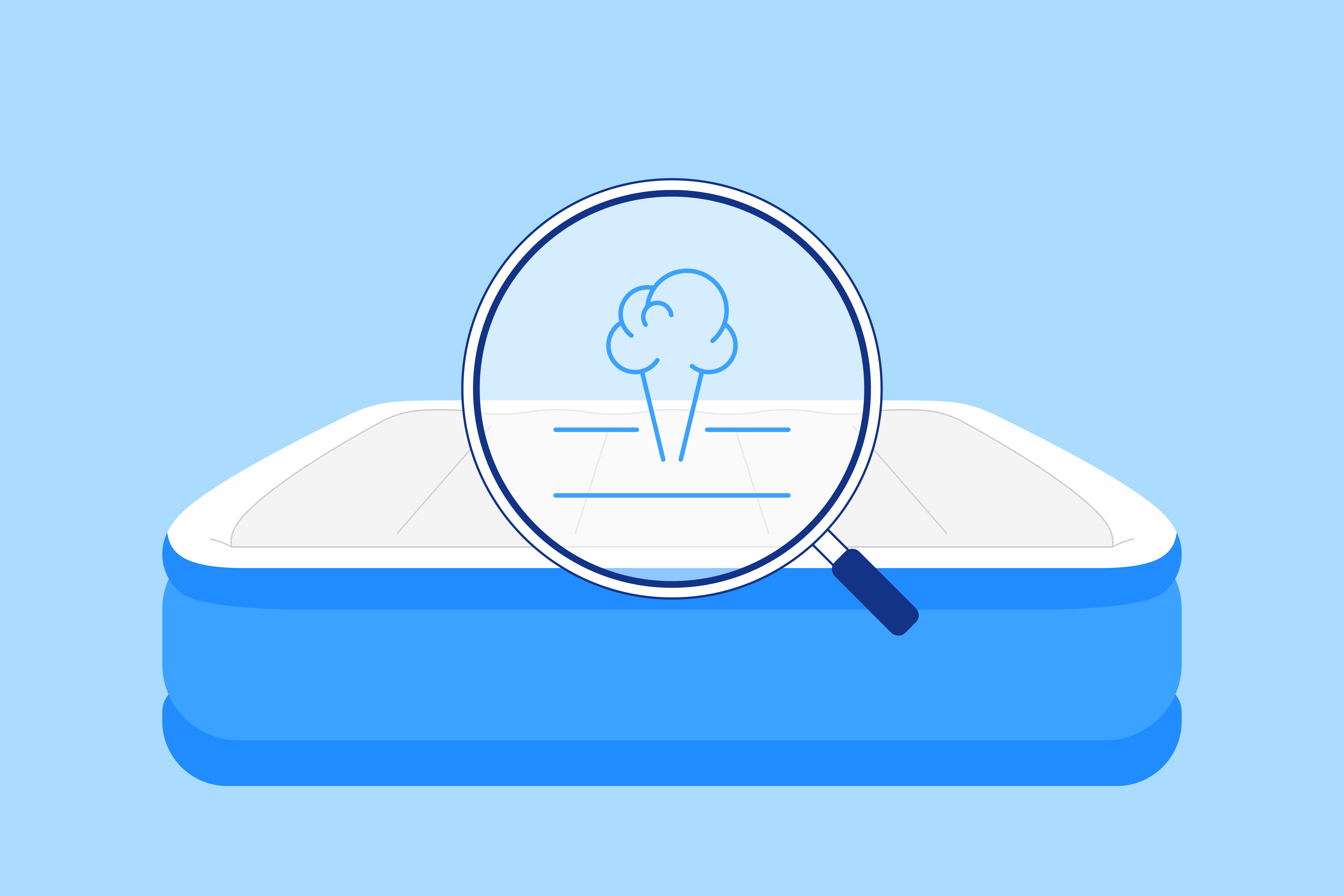If you have been shopping for or researching a memory foam mattress, there’s a good chance you’ve heard a few things, such as “memory foam is hot” or “memory foam is unhealthy”. Usually, these claims are made without much substantiation other than anecdotal accounts but can be enough to cause concern for many people.
There are many memory foam mattress myths floating around online, and as with most myths, they usually evolve from a bit of truth that gets exaggerated or taken out of context.
In this article, we will look at the most popular memory foam mattress myths, their origins, and the facts to cut through the confusion. And we’ll do our best to present an accurate portrait of memory foam so readers can make an informed decision.
Best Amerisleep Memory Foam Mattresses
Quick Guide: A 30-Second Summary
| Best Memory Foam Mattress Overall | Amerisleep AS3 |
| Best Firm Memory Foam Mattress | Amerisleep AS2 |
| Best Soft Memory Foam Mattress | Amerisleep AS5 |
Myth: Memory Foam Sleeps Hot & Makes You Sweat
 Origin: Older, less breathable types of memory foams do limit air flow, and dense, temperature sensitive foams contour closely to sleepers’ bodies. This can leave feel people feeling warm, especially those who naturally sleep hot.
Origin: Older, less breathable types of memory foams do limit air flow, and dense, temperature sensitive foams contour closely to sleepers’ bodies. This can leave feel people feeling warm, especially those who naturally sleep hot.
The Facts: This myth is true, but only for dense foams (over 5.0 lbs) with temperature-sensitive properties. Foams that are temperature-neutral contour instantly with pressure, and respond quicker to sleepers’ movements. This eliminates the sinking sensation, and because the memory foam is temperature-stable, the firmness is consistent across the mattress surface.
There are significant differences between different types of memory foam. We found in our investigations that traditional foam mattresses tend to sleep hot for 10-15% of people, gel memory foam is 5-10%, and plant-based memory foams 2-8%.
So, while some memory foam can sleep hot, there are types that have been developed to breathe better, and heat retention affects only a small minority of owners overall. To make sure you get a cooling mattress, read through consumer reviews with an eye for people who talk about sleeping hot or cool
Myth: Memory Foam Stinks
 Origin: Polyurethane foams traditionally contain various petrochemicals and additives than can have residual odors, just like new furniture, new cars, new paints and other manufactured items.
Origin: Polyurethane foams traditionally contain various petrochemicals and additives than can have residual odors, just like new furniture, new cars, new paints and other manufactured items.
The Facts: Memory foam can have a smell, especially when it is sealed in plastic right after it is manufactured and prepared to be shipped as mail order mattresses. However, odors should dissipate within a few days to a few weeks. Denser memory foams are more likely to smell, while less dense foams or ones that use less petroleum products or VOC-producing chemicals are less likely to have strong smells.
While temporary off-gassing odors aren’t unheard of, we found in our research that few consumers return a mattress for that reason alone. Comparing third-party reviews for mattress brands, we found that our Amerisleep beds, made with medium density, plant-based memory foam, have very low complaints of strong odors, contrasted with mattresses that rely on medium to higher density traditional foams.
| Brand | Mattress Type | Percent of Reviews Mentioning Strong Odor |
|---|---|---|
| Amerisleep | Plant-Based | 3% |
| iComfort® by Serta | Gel & Traditional | 8% |
| Tempur-Pedic® | Traditional | 18% |
Information in table taken from third-party reviews on Amerisleep.com, and customer reviews and specifications on Tempurpedic.com and Serta.com.
Myth: Memory Foam Is Toxic
 Origin: Polyurethanes and memory foam produced before the 1980s and 1990s sometimes contained harsh chemicals like formaldehyde, chlorofluorocarbons, PBDEs and other volatile organic compounds (chemicals that break down overtime and outgas into the air). Other chemicals used in the memory foam making process also have some shocking warning labels in their raw form.
Origin: Polyurethanes and memory foam produced before the 1980s and 1990s sometimes contained harsh chemicals like formaldehyde, chlorofluorocarbons, PBDEs and other volatile organic compounds (chemicals that break down overtime and outgas into the air). Other chemicals used in the memory foam making process also have some shocking warning labels in their raw form.
The Facts: Memory foam mattresses produced in the 1980s and 90s contained harsh chemicals. Some companies also use chemical flame retardants that can further contribute to off-gassing (versus fabric barriers). The biggest concerns are inhalation and absorption through the skin, however most of the risks are presented during manufacturing.
People who complain of side effects, like difficulty breathing or eye/throat irritation, usually mention co-occurring strong chemical odors, associated with high VOC content and the aforementioned chemicals in mattresses.
MSDS for memory foam shows the primary concern of coarse dust causing mechanical lung or eye irritation. However, unless you are chopping up your mattress you aren’t likely to be exposed to coarse dust.
American and European mattress brands have phased most of the worst offenders like CFCs, formaldehyde and carcinogenic PBDEs out of their production processes due to public concern, environmental restrictions, and government regulations. Non-toxic and chemical-free mattresses are their priority as much as consumers.
The replacement fire barrier material that sprung up to replace mattress flame retardants, fiberglass, is also being phased out due to consumer concerns. Fiberglass is common inside memory foam mattresses produced to maximize affordability, but many are making the switch to other synthetic or natural materials that resist flame, like wool, the minerals graphite or silica, and even Kevlar.
In short, you needn’t worry about whether or not memory foam is safe overall as a material. You can rest easy that yes, it can be produced safely.

However, trade secrets limit the amount of information available publicly, especially for imported foams or mattresses. Compounds that people find most concerning in today’s foams are methylene chloride, methylene dianiline, methyl benzene and vinylidene chloride, which are suspected carcinogens and/or mucous membrane/nervous system irritants in the raw formats.
If you want to rest safely, it’s always best to go with a mattress made in the U.S. It’s also easier to doublecheck the manufacturer claims and do your own research.
And as we noted, not all memory foam is riddled with toxic substances. For people seeking to reduce household chemicals with eco-friendly mattresses, the independent Certi-PUR® organization tests polyurethane foams for VOC-levels, banned phthalates, formaldehyde, CFCs and overall durability. Foams with Certi-PUR® certification were found to have low-VOC levels and to meet the established chemical standards.
Amerisleep uses certified foams, and also has a very low rate of complaint for odors. We have also strived to ensure all the mattresses we make now are fiberglass-free mattresses.
Myth: Memory Foam Feels like Quicksand
 Origin: Dense, temperature-sensitive memory foam relies on body heat to soften and contour. This results in a gradual softening that can feel like sinking. In thicker, dense memory foam, the contouring can leave some people feeling stuck, and make it harder to move around or get out of bed.
Origin: Dense, temperature-sensitive memory foam relies on body heat to soften and contour. This results in a gradual softening that can feel like sinking. In thicker, dense memory foam, the contouring can leave some people feeling stuck, and make it harder to move around or get out of bed.
The Facts: This myth is true, but only for dense foams (over 5.0 lbs) with temperature-sensitive properties. Foams that are temperature-neutral contour instantly with pressure, and respond quickly to sleepers’ movements. This eliminates the sinking sensation, and because the memory foam is temperature-stable, the firmness level is consistent across the mattress surface.
| Brand | Amerisleep | iComfort® by Serta | Tempur-Pedic® |
|---|---|---|---|
| Type | Temperature-Neutral | Temperature-Sensitive | Temperature-Sensitive |
| Response Time | Fast (8 seconds) | Moderate (15-30 seconds) | Slow (45-60 seconds) |
| Density | 4.5 - 5.3 lbs | 3.0 - 5.0 lbs | 2.5 - 7.0 lbs |
Information in table taken from third-party reviews on Amerisleep.com, and customer reviews and specifications on Tempurpedic.com and Serta.com.
Myth: Memory Foam Is Expensive
 Origin: The first brand of memory foam to go mainstream, Tempur-Pedic®, positions itself as higher-end luxury brand. Because their average mattresses range around $3000 to $5000, many people continue to believe memory foam is always expensive.
Origin: The first brand of memory foam to go mainstream, Tempur-Pedic®, positions itself as higher-end luxury brand. Because their average mattresses range around $3000 to $5000, many people continue to believe memory foam is always expensive.
The Facts: Memory foam does cost more to produce than standard polyurethane foams, but today, many manufacturers make the material. Because memory foam is produced in greater quantities and there is now greater marketplace competition, many affordable brands have popped up. Brands that price their beds in the luxury range often do so to create a certain brand image or to finance their extensive and costly national advertising programs.
When shopping for a memory foam bed, you may see mattresses with similar densities and specifications that range significantly in price. Many good-quality memory foam beds, and even a few luxury mattresses, are available that are priced similar to or even cheaper than leading innerspring brands.
And not all brands that cost more use high-quality materials. In other words, you shouldn’t take a high price tag as a mark of quality. Many of the best mattresses cost under $2000 and deliver years of comfort.
| Memory Foam Mattress Model | Price (Queen Size) |
|---|---|
| Amerisleep AS2 | $1099 |
| Amerisleep AS3 | $1299 |
| Amerisleep AS5 | $1899 |
More Types of Mattresses to Consider
When comparing these mattress types to memory foam, it’s important to consider factors such as comfort, support, durability, and temperature regulation. Each mattress type offers distinct features that cater to different sleep preferences and needs.
Latex
Latex mattresses offer a natural alternative to memory foam. They are made from latex foam, which provides responsive support and contouring to the body. Latex is known for its durability and breathability, allowing for better airflow and temperature regulation.
See also our guide on latex vs memory foam mattresses.
Innerspring
Innerspring mattresses use metal coils for support. They offer a traditional and bouncy feel, with good airflow for temperature control. Innersprings come in different firmness levels and are known for their durability.
See also our guide on innerspring vs memory foam mattresses.
Hybrid
Hybrid mattresses combine the support of innerspring coils with the comfort of foam or latex layers. They offer a balanced combination of bounce, support, and pressure relief. Hybrids are a popular choice for those seeking the benefits of different materials in one mattress.
See also our guide on hybrids vs memory foam mattresses.
Air
Air mattresses feature adjustable air chambers that allow users to customize firmness levels. They are often used for camping or temporary sleep solutions. Air mattresses offer personalized comfort by adjusting the air pressure.
See also our guide on air vs memory foam mattresses.
Waterbeds
Waterbeds provide a unique floating sensation as they are filled with water. They offer pressure relief and customizable support. Waterbeds come in various designs, including waveless options, and may have temperature control features.
See also our guide to memory foam vs waterbeds.
Frequently Asked Questions
Do air purifiers help with memory foam off-gassing?
The benefits of air purifiers include improving the air quality and reducing odors in a room, including those associated with off-gassing from memory foam mattresses. While air purifiers may help to some extent, it’s important to note that off-gassing is a natural process that occurs when new materials release volatile organic compounds (VOCs).
To minimize off-gassing, we recommend letting the mattress fully expand and air out in a well-ventilated room before use.
Are cheap memory foam mattresses worth it?
While cheap memory foam mattresses may be more affordable, they may also compromise on durability, comfort, and support. Lower-priced options may have lower-density foam or lack advanced features such as cooling technology. Investing in a higher-quality memory foam mattress can provide better longevity, comfort, and overall satisfaction.
Balancing your budget between price and quality can be a delicate act, but it’s important when making a mattress purchase decision. Remember also that you shouldn’t have to overpay to enjoy a good mattress. Instead of the $3000 to $5000 some manufacturers charge for a mattress, luxury or otherwise, you can find yourself a quality mattress for $1000 to $2000.
Should children sleep on a memory foam mattress?
Memory foam mattresses can be suitable for children. However, certain considerations should be taken into account. You should consult with your pediatrician or healthcare professional for specific recommendations based on the child’s age and individual needs.
As a rule of thumb, it is important to select a mattress for kids that provides adequate support for a child’s developing body. Additionally, it’s crucial to choose a mattress that meets safety standards and regulations with certifications like CertiPUR-US®.
How much should you pay for a memory foam mattress?
Generally, prices for a queen size memory foam mattress can range from a few hundred dollars to several thousand dollars. Set a budget and conduct research to find reputable mattress brands offering good value for money is advisable.
Remember that a higher price doesn’t always guarantee superior quality. It’s important to consider the quality, durability, and features that align with your preferences and needs before making a purchase.
What happens when memory foam gets old?
Over time, memory foam mattresses will experience some changes from extended use. As the foam ages, it may lose some of its original properties, such as its firmness or its responsiveness. In other words, the memory foam mattress may get softer or firmer, or it may lose some of its springiness and become slow to regain its original shape.
The mattress may also become less supportive and show signs of wear and tear. This can lead to reduced comfort and potentially impact the quality of sleep. You are more likely to wake up with ailments like back pain on an older memory foam mattress. When this happens, it’s time to replace a mattress.
The Bottom Line
So, now you know the truth about memory foam and have a better idea of what to look for in mattresses in a box. Just like with other product myths and legends, memory foam mattress myths are part fact and part fiction. So don’t be sold on or scared by statements that all memory is hot or all memory foam smells.
Knowing what separates types of memory foam and what actually impacts comfort and satisfaction are important when shopping for a new bed, and researching rather than accepting memory foam mattress myths or anecdotes at face value can help you choose the right mattress for your needs without missing out on comfort.
About the author
April Mayer is a sleep expert and writer with a degree in exercise physiology. She has dedicated her career to exploring the relationship between sleep and productivity. Her insightful articles, such as "The Surprising Way Your Mood Might Be Messing With Your Productivity" and "Wake Up to More Productive Mornings," have been featured in reputable publications like Forbes, Greatist, Real Homes, Thrillist, Tom's Guide, and Eat This, Not That. With a passion for helping others lead more productive lives through restful sleep, April offers valuable expertise on foods and vitamins for better sleep. As a trusted member of the Early Bird team since March 2020, she continues to provide informative and well-researched content.
View all posts





